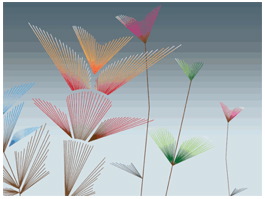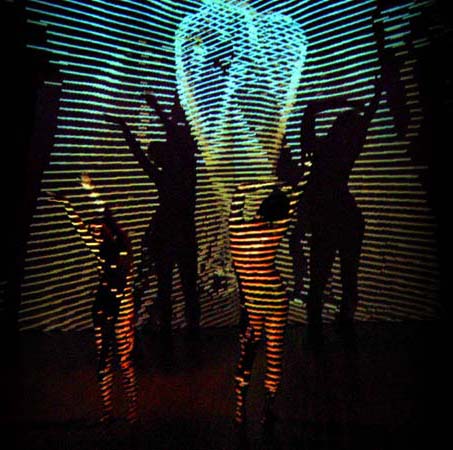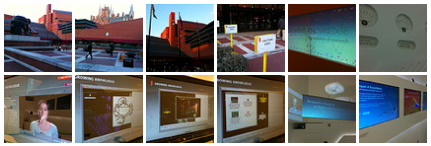25
01
2011
Picture – 360 degree panoram of the inside of the British Library exhibition room with the e-Dance videos. Very clinical white, with lots of lighting points.

Once you have finished with the videos, interactive screens, touch-table exampes etc., it is quiet a nice place to read your emails.
Comments : 4 Comments »
Categories : Dissemination, Media
12
10
2010

Today sees the launch of the British Library’s major new exhibition on how digital tools are already transforming how we do research: Growing Knowledge: The Evolution of Research (12 October 2010 – 16 July 2011). [Media coverage]
We’re delighted to say that the e-Dance Project was selected as one of the examples, showcasing how close collaboration between technology researchers (originally developing Access Grid video-conferencing/collaboration tools, and Compendium hypermedia mapping, in an e-Science context) enables arts and humanities researchers, in this case Choreographic researchers/practitioners, to break new ground playing with time and space in their discipline.
The e-Dance exhibit presents video material introducing the project, with examples of the technologies in action. Some of this is on the BLGK demos website, an extract from an extended podcast playlist.
Browse the blog to learn more, and to download the Access Grid Scene Editor and Compendium e-Dance Edition.
![Early e-Dance: Access Grid multiple=]()
This article sets out the academic rationale for e-Dance:
Bailey, H., Bachler, M., Buckingham Shum, S., Le Blanc, A., Popat, S., Rowley, A. and Turner, M. (2009). Dancing on the Grid: Using e-Science Tools to Extend Choreographic Research. Philosophical Transactions of the Royal Society A, 13 July 2009, Vol. 367, No. 1898, pp. 2793-2806. [PDF]

Comments : 3 Comments »
Categories : AG, Dissemination, Event, Media, Software, Team
11
09
2009
A quick pointer to the “Another Language” newsletter from our friends in Utah: Volume 6 Issue 3 is just out. The next INTERPLAY: EVENT HORIZONS is due in March 26 – April 4, 2010
Comments : No Comments »
Categories : Media
20
02
2009
“Repository of Access Grid Collaborative Events (RACE) Workshop”
19th February 2009, CS1.10, Kilburn Building, University of Manchester
http://www.rcs.manchester.ac.uk/community/confevents/RACEWorkshop
A short half-day workshop presented various video/AG projects including eDance. Video Conferencing is far more now than just video and audio – but includes interaction with other data formats as well as various ways to present data.
The workshop considered users of video repositories and their use, a questionnare is at:
http://www.rcs.manchester.ac.uk/research/race/usereval
Main RACE web-page:
http://www.rcs.manchester.ac.uk/research/race
The eDance player and editing system was explained in step-by-step detail and demonstrated on a projection system.
Comments : No Comments »
Categories : Dissemination, Media
1
10
2008
 Â
Â
I have been selected as one of the ten artists to take part in the MIMA (Moving Image Media Artists) workshop with Troika Ranch in http://www.troikaranch.org/ New York at the end of October. This week-long workshop will give me the opportunity to work directly with Mark Coniglio, the Co-director of Troika Ranch and developer of Isadora. It should provide a useful context for discusson about the e-Dance software development and give me a much greater insight into the capabilities that Isadora offers.
Comments : No Comments »
Categories : Media, Theory
16
05
2008
I’m going to be doing an on-line interview with Torsten Reimer on the www.arts-humanities.net website. It will start some time towards the end of May.
Comments : No Comments »
Categories : Dissemination, Media
1
11
2007
The e-Dance predecesor CSAGE as a VRE (Virtual Research Environment) is briefly mentioned in a News article in JISC Inform Vol 19 – October 2007. DVD copy of the videos are available describing CSAGE as well as other VRE projects. This included a photo of the projected and post-edited StereoBodies performance.
http://www.jisc.ac.uk/publications/publications/inform19
Copy of news article: “New videos showcase best in collaborative research  Two videos that explain how projects from the first phase of JISC’s Virtual Research Environments (VRE) programme are bringing researchers together through VREs have been launched.
Two videos that explain how projects from the first phase of JISC’s Virtual Research Environments (VRE) programme are bringing researchers together through VREs have been launched.
Projects highlighted in the videos show how researchers in the materials sciences, for example, have been able to share results in real time with other remote teams of specialists; how dancers have been performing in remote environments (see image); how groups of historians have been ‘meeting’ remotely and collaborating across more than a dozen institutions, and so on.
Frederique van Till, JISC’s Programme Manager for the VRE programme, now in its second phase, said: ‘We’re delighted to have such a range of perspectives and research backgrounds on these films. What has really come through is that there is no one-size-fits-all solution, just as no two research projects are the same.'”
Comments : No Comments »
Categories : Dissemination, Media
10
09
2007
e-Dance is highlighted today in the JISC briefing Research in the arts and humanities: an overview of JISC activities. Â
“e-Science in the arts and humanitiesSuch investigations are not only opening up new avenues in arts and humanities research, but are also testing and extending the present range of e-science technologies. An example is the development of the Access Grid, a form of advanced video conferencing for distributed collaborations in performing arts and motion capture (see box left).  Â
Dancing with virtual partners
A ground-breaking project on dance choreography is being funded by the joint AHRC/EPSRC/JISC Arts and Humanities e-Science Initiative. Led by the University of Bedfordshire, using Access Grid technology, Relocating Choreographic Process will develop a suite of software tools to enable choreographers to annotate dance video recordings, plan collaborative pieces using networked virtual spaces over the internet, and weave material from recordings into live performances. This will give the Access Grid, originally developed for advanced video conferencing purposes, a powerful and exciting new role as a medium for collaborative artistic performance and related research.”
Comments : 1 Comment »
Categories : Media






 Two videos that explain how projects from the first phase of JISC’s Virtual Research Environments (VRE) programme are bringing researchers together through VREs have been launched.
Two videos that explain how projects from the first phase of JISC’s Virtual Research Environments (VRE) programme are bringing researchers together through VREs have been launched.


